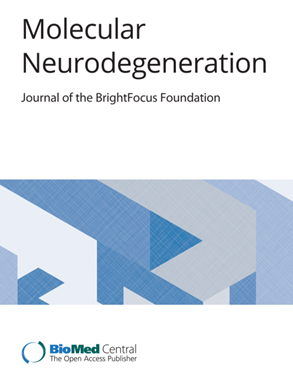硬脂酰-CoA 去饱和酶-1:神经系统疾病的潜在治疗靶点
IF 14.9
1区 医学
Q1 NEUROSCIENCES
引用次数: 0
摘要
脂肪酸脂质体的紊乱越来越被认为是导致各种脑部疾病恶化的关键因素。在这篇综述文章中,我们将深入探讨Δ9脂肪酸去饱和酶,特别是硬脂酰-CoA去饱和酶-1(SCD1)在神经炎症、神经变性和脑修复中的影响。在过去的几年里,人们已经证实,抑制或缺乏 SCD1 不仅能抑制神经炎症,还能防止多发性硬化症、阿尔茨海默病和帕金森病等疾病的神经变性。这种保护作用是通过不同的机制实现的,包括增强髓鞘再形成、逆转突触和认知障碍以及减轻α-突触核蛋白毒性。耐人寻味的是,通过 SCD1 改变脂肪酸的代谢路线可以改善与 X 连锁肾上腺白质营养不良症相关的病理现象,这表明 SCD1 抑制作用对大脑的良性和有害影响是相互依赖的。在此,我们总结并讨论了 SCD1 在这些神经系统疾病中有益和有害作用的细胞和分子机制。我们探讨了共同点和不同点,揭示了潜在的治疗挑战。此外,我们还探讨了未来的研究方向,这些方向有望加深我们对 SCD1 在脑部疾病中生物学作用的理解,并有可能提高 SCD1 抑制剂的临床效用。本文章由计算机程序翻译,如有差异,请以英文原文为准。
Stearoyl-CoA desaturase-1: a potential therapeutic target for neurological disorders
Disturbances in the fatty acid lipidome are increasingly recognized as key drivers in the progression of various brain disorders. In this review article, we delve into the impact of Δ9 fatty acid desaturases, with a particular focus on stearoyl-CoA desaturase-1 (SCD1), within the setting of neuroinflammation, neurodegeneration, and brain repair. Over the past years, it was established that inhibition or deficiency of SCD1 not only suppresses neuroinflammation but also protects against neurodegeneration in conditions such as multiple sclerosis, Alzheimer’s disease, and Parkinson’s disease. This protective effect is achieved through different mechanisms including enhanced remyelination, reversal of synaptic and cognitive impairments, and mitigation of α-synuclein toxicity. Intriguingly, metabolic rerouting of fatty acids via SCD1 improves the pathology associated with X-linked adrenoleukodystrophy, suggesting context-dependent benign and harmful effects of SCD1 inhibition in the brain. Here, we summarize and discuss the cellular and molecular mechanisms underlying both the beneficial and detrimental effects of SCD1 in these neurological disorders. We explore commonalities and distinctions, shedding light on potential therapeutic challenges. Additionally, we touch upon future research directions that promise to deepen our understanding of SCD1 biology in brain disorders and potentially enhance the clinical utility of SCD1 inhibitors.
求助全文
通过发布文献求助,成功后即可免费获取论文全文。
去求助
来源期刊

Molecular Neurodegeneration
医学-神经科学
CiteScore
23.00
自引率
4.60%
发文量
78
审稿时长
6-12 weeks
期刊介绍:
Molecular Neurodegeneration, an open-access, peer-reviewed journal, comprehensively covers neurodegeneration research at the molecular and cellular levels.
Neurodegenerative diseases, such as Alzheimer's, Parkinson's, Huntington's, and prion diseases, fall under its purview. These disorders, often linked to advanced aging and characterized by varying degrees of dementia, pose a significant public health concern with the growing aging population. Recent strides in understanding the molecular and cellular mechanisms of these neurodegenerative disorders offer valuable insights into their pathogenesis.
 求助内容:
求助内容: 应助结果提醒方式:
应助结果提醒方式:


